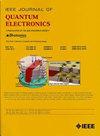Heater-Tuned Single-Grating Distributed Bragg Reflector Lasers With a Thermal Confinement Waveguide Structure
IF 2.1
3区 工程技术
Q3 ENGINEERING, ELECTRICAL & ELECTRONIC
引用次数: 0
Abstract
To evaluate the effect of thermally isolated waveguide structure in a heater-based tunable distributed Bragg reflector (DBR) laser, the temperature distribution and thermo-optical characteristics are investigated at various heater powers. The reflection spectrum of the DBR is designed, and the tuning characteristics of the fabricated DBR laser are compared with simulation results. It is found that the waveguide temperature increases linearly with the heater power, whereas the effective refractive index increases nonlinearly, resulting in the corresponding nonlinear wavelength-tuning characteristics. In order to obtain efficient thermal tuning characteristics, a thermal isolation structure of the reverse-mesa waveguide is introduced. In this device, the temperature of the waveguide core increases steeply at low tuning power levels, resulting in highly efficient wavelength tuning properties. On the other hand, at high tuning power, the DBR reflection spectrum broadens and the side-mode suppression ratio (SMSR) performances degrades. These effects are found to be caused mainly by non-uniform temperature distribution along the longitudinal direction.热约束波导结构的热调谐单光栅分布式布拉格反射激光器
为了评估热隔离波导结构对基于加热器的可调谐分布式布拉格反射器(DBR)激光器的影响,研究了不同加热器功率下的温度分布和热光学特性。设计了DBR激光器的反射光谱,并将制备的DBR激光器调谐特性与仿真结果进行了比较。发现波导温度随加热器功率的增加呈线性增加,而有效折射率随加热器功率的增加呈非线性增加,从而产生相应的非线性波长调谐特性。为了获得高效的热调谐特性,提出了一种反台波导的热隔离结构。在该器件中,波导芯的温度在低调谐功率水平下急剧上升,从而产生高效的波长调谐特性。另一方面,在高调谐功率下,DBR反射频谱变宽,侧模抑制比(SMSR)性能下降。这些影响主要是由温度沿纵向分布不均匀引起的。
本文章由计算机程序翻译,如有差异,请以英文原文为准。
求助全文
约1分钟内获得全文
求助全文
来源期刊

IEEE Journal of Quantum Electronics
工程技术-工程:电子与电气
CiteScore
4.70
自引率
4.00%
发文量
99
审稿时长
3.0 months
期刊介绍:
The IEEE Journal of Quantum Electronics is dedicated to the publication of manuscripts reporting novel experimental or theoretical results in the broad field of the science and technology of quantum electronics. The Journal comprises original contributions, both regular papers and letters, describing significant advances in the understanding of quantum electronics phenomena or the demonstration of new devices, systems, or applications. Manuscripts reporting new developments in systems and applications must emphasize quantum electronics principles or devices. The scope of JQE encompasses the generation, propagation, detection, and application of coherent electromagnetic radiation having wavelengths below one millimeter (i.e., in the submillimeter, infrared, visible, ultraviolet, etc., regions). Whether the focus of a manuscript is a quantum-electronic device or phenomenon, the critical factor in the editorial review of a manuscript is the potential impact of the results presented on continuing research in the field or on advancing the technological base of quantum electronics.
 求助内容:
求助内容: 应助结果提醒方式:
应助结果提醒方式:


